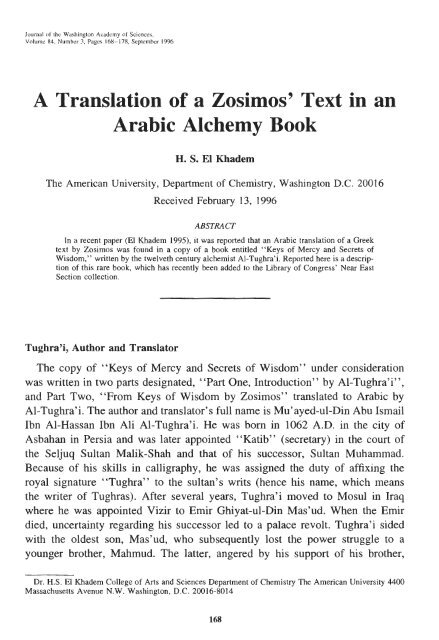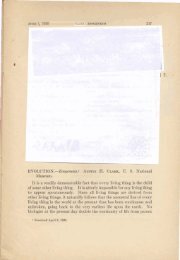A Translation of a Zosimos' Text in an Arabic Alchemy Book
A Translation of a Zosimos' Text in an Arabic Alchemy Book
A Translation of a Zosimos' Text in an Arabic Alchemy Book
You also want an ePaper? Increase the reach of your titles
YUMPU automatically turns print PDFs into web optimized ePapers that Google loves.
Journal rrl' lhc Wilsh<strong>in</strong>glon Academy ol' Scicnccs.<br />
Volumc 84. Numhcr 3, Pages 168-178. Septcmhcr 1996<br />
A <strong>Tr<strong>an</strong>slation</strong> <strong>of</strong> a <strong>Zosimos'</strong> <strong>Text</strong> <strong>in</strong> <strong>an</strong><br />
<strong>Arabic</strong> <strong>Alchemy</strong> <strong>Book</strong><br />
H. S. El Khadem<br />
The Americ<strong>an</strong> University, Department <strong>of</strong> Chemistry, Wash<strong>in</strong>gton D.C. 20016<br />
Received February 13, 1996<br />
ABSTRACT<br />
In a recent paper (El Khadem 1995). it was reported that <strong>an</strong> <strong>Arabic</strong> tr<strong>an</strong>slation <strong>of</strong> a Greek<br />
text by Zosimos was found <strong>in</strong> a copy <strong>of</strong> a book entitled "Keys <strong>of</strong> Mercy <strong>an</strong>d Secrets <strong>of</strong><br />
Wisdom," written by the twelveth century alchemist Al-Tughra'i. Reported here is a descrip-<br />
tion <strong>of</strong> this rare book, which has recently been added to the Library <strong>of</strong> Congress' Near East<br />
Section collection.<br />
Tughra'i, Author <strong>an</strong>d Tr<strong>an</strong>slator<br />
The copy <strong>of</strong> "Keys <strong>of</strong> Mercy <strong>an</strong>d Secrets <strong>of</strong> Wisdom" under consideration<br />
was written <strong>in</strong> two parts designated, "Part One, Introduction" by Al-Tughra'i",<br />
<strong>an</strong>d Part Two, "From Keys <strong>of</strong> Wisdom by Zosimos" tr<strong>an</strong>slated to <strong>Arabic</strong> by<br />
Al-Tughra'i. The author <strong>an</strong>d tr<strong>an</strong>slator's full name is Mu'ayed-ul-D<strong>in</strong> Abu Ismail<br />
Ibn Al-Hass<strong>an</strong> Ibn Ali Al-Tughra'i. He was born <strong>in</strong> 1062 A.D. <strong>in</strong> the city <strong>of</strong><br />
Asbah<strong>an</strong> <strong>in</strong> Persia <strong>an</strong>d was later appo<strong>in</strong>ted "Katib" (secretary) <strong>in</strong> the court <strong>of</strong><br />
the Seljuq Sult<strong>an</strong> Malik-Shah <strong>an</strong>d that <strong>of</strong> his successor, Sult<strong>an</strong> Muhammad.<br />
Because <strong>of</strong> his skills <strong>in</strong> calligraphy, he was assigned the duty <strong>of</strong> affix<strong>in</strong>g the<br />
royal signature "Tughra" to the sult<strong>an</strong>'s writs (hence his name, which me<strong>an</strong>s<br />
the writer <strong>of</strong> Tughras). After several years, Tughra'i moved to Mosul <strong>in</strong> Iraq<br />
where he was appo<strong>in</strong>ted Vizir to Emir Ghiyat-ul-D<strong>in</strong> Mas'ud. When the Emir<br />
died, uncerta<strong>in</strong>ty regard<strong>in</strong>g his successor led to a palace revolt. Tughra'i sided<br />
with the oldest son, Mas'ud, who subsequently lost the power struggle to a<br />
younger brother, Mahmud. The latter, <strong>an</strong>gered by his support <strong>of</strong> his brother,<br />
Dr. H.S. El Khadem College <strong>of</strong> Arts <strong>an</strong>d Sciences Department <strong>of</strong> Chemistry The Americ<strong>an</strong> University 4400<br />
Massachusetts Avenue N.W. Wash<strong>in</strong>gton, D.C. 20016-8014
ZOSIMOS' TEXT 169<br />
arr<strong>an</strong>ged to have him accused <strong>of</strong> heresy <strong>an</strong>d then had him beheaded <strong>in</strong> the year<br />
1121 A.D. Tughra'i's execution caused dismay among the learned community<br />
<strong>in</strong> the region <strong>an</strong>d prompted m<strong>an</strong>y publishers to delete all what they considered<br />
controversial from his books.<br />
Tughra'i was a statesm<strong>an</strong>, <strong>an</strong> alchemist <strong>an</strong>d a poet, considered by m<strong>an</strong>y as<br />
one <strong>of</strong> the key literary figures <strong>of</strong> his time (see Nicholson 1941). The present text,<br />
which accord<strong>in</strong>g to <strong>an</strong> <strong>an</strong>notation on its title page, was also known as: "Key <strong>of</strong><br />
Mercy <strong>an</strong>d L<strong>an</strong>tern <strong>of</strong> Wisdom" <strong>an</strong>d "Key <strong>of</strong> the Treasures <strong>an</strong>d L<strong>an</strong>tern <strong>of</strong> the<br />
Symbol", has been cited by authors, such as Ullm<strong>an</strong>n (1972), who lists it as<br />
"Keys <strong>of</strong> Mercy <strong>an</strong>d L<strong>an</strong>terns <strong>of</strong> Wisdom", <strong>an</strong>d Sezg<strong>in</strong> (1971) <strong>an</strong>d Kraus (1943)<br />
who list it as "Keys <strong>of</strong> Mercy". None <strong>of</strong> these authors, however, mentions that<br />
this, or <strong>an</strong>y other book by Tughra'i, conta<strong>in</strong>s a tr<strong>an</strong>slation <strong>of</strong> a text by Zosimos.<br />
A possible expl<strong>an</strong>ation <strong>of</strong> this absence is that the tr<strong>an</strong>slation <strong>of</strong> <strong>Zosimos'</strong> text<br />
was deemed sufficiently controversial to delete it from m<strong>an</strong>y copies <strong>of</strong> "Keys<br />
<strong>of</strong> Mercy."<br />
Zosimos:<br />
Zosimos, the author <strong>of</strong> Part Two <strong>of</strong> the present text, was the most famous<br />
alchemist <strong>of</strong> his time. He was a gnostic philosopher, born <strong>in</strong> the city <strong>of</strong> P<strong>an</strong>opolis<br />
(present day Akhmim) <strong>in</strong> Southern Egypt around the year 300 A.D. He lived <strong>in</strong><br />
Alex<strong>an</strong>dria, <strong>an</strong>d traveled to m<strong>an</strong>y parts <strong>of</strong> the Hellenic world (see Read 1937,<br />
<strong>an</strong>d Hopk<strong>in</strong>s 1967). Although Zosimos was a prolific writer, all his books have<br />
been lost <strong>an</strong>d what rema<strong>in</strong>s <strong>of</strong> them today are mere passages <strong>an</strong>d quotes written<br />
<strong>in</strong> the orig<strong>in</strong>al Greek l<strong>an</strong>guage, or tr<strong>an</strong>slated to Syriac or <strong>Arabic</strong>. The Greek <strong>an</strong>d<br />
Syriac texts have been tr<strong>an</strong>slated to French by Berthelot (1 885, 1888, 1893) <strong>an</strong>d<br />
discussed <strong>in</strong> detail by Halleux (1979) <strong>an</strong>d Mertens (1990).<br />
<strong>Arabic</strong> tr<strong>an</strong>slations <strong>of</strong> <strong>Zosimos'</strong> work are listed by Sezg<strong>in</strong> (1971, p. 73) <strong>an</strong>d<br />
by Ullm<strong>an</strong>n (1972, p. 160). They are also listed <strong>in</strong> the <strong>Arabic</strong> encyclopedia,<br />
"Kitab al-Fihrist", published <strong>in</strong> Baghdad <strong>in</strong> 987 A.D., by Ibn A1-Nadim (1872).<br />
In Section Ten <strong>of</strong> this book, Nadim gives the titles <strong>of</strong> four books authored by<br />
Zosimos (see Flugel 1872); they are: "Keys <strong>of</strong> the Craft," by "Rimos," (its<br />
title was tr<strong>an</strong>slated by Berthelot 1888, p. 28) as "Keys <strong>of</strong> the Work"); "Keys<br />
<strong>of</strong> Magic," by "Thosimos"; "The <strong>Book</strong> <strong>of</strong> Elements," by "Dosimos" <strong>an</strong>d<br />
"<strong>Book</strong> to All the Wise <strong>of</strong> the Craft" also by Dosimos. The <strong>in</strong>consistency <strong>in</strong><br />
spell<strong>in</strong>g <strong>Zosimos'</strong> name c<strong>an</strong> be traced to two reasons: (a) <strong>Arabic</strong> vowels may be<br />
deleted, altered, or tr<strong>an</strong>sposed, accord<strong>in</strong>g to certa<strong>in</strong> rules, to render foreign names<br />
easier to pronounce; (b) the pairs <strong>of</strong> <strong>Arabic</strong> letters "Ra" <strong>an</strong>d "Za" that produce<br />
the sounds "R" <strong>an</strong>d "2," <strong>an</strong>d "Dal" <strong>an</strong>d "Thal," that produce the sounds
170 KHADEM<br />
"D," <strong>an</strong>d "Th" (as <strong>in</strong> "the") are identical <strong>in</strong> shape, except for a dot on top <strong>of</strong><br />
the second letter <strong>of</strong> each pair. A dot on the letter "Ra" ch<strong>an</strong>ges it to "Za" <strong>an</strong>d<br />
a dot on "Dal," forms the letter "Thal," In the writ<strong>in</strong>gs <strong>of</strong> Geber, Avicenna<br />
<strong>an</strong>d Tughra'i, Zosimos is referred to as Rismos or Zismos, depend<strong>in</strong>g on whether<br />
the copier <strong>of</strong> the m<strong>an</strong>uscript remembered to put the dot. For example on p. 2 <strong>of</strong><br />
the Introduction <strong>of</strong> the present text, <strong>Zosimos'</strong> name is spelled with a dot, whereas<br />
on the title page <strong>of</strong> Part Two it is spelled without the dot. Nadim, probably did<br />
not realize that the authors he lists as Rimos, Thosimos <strong>an</strong>d Dosimos were one<br />
<strong>an</strong>d the same person. Furthermore, because "The Craft," "The Work," <strong>an</strong>d<br />
"Magic," were synonyms used to describe "<strong>Alchemy</strong>," it is quite possible that<br />
<strong>Zosimos'</strong> books listed as, "Keys <strong>of</strong> the Craft," <strong>an</strong>d "Keys <strong>of</strong> Magic," were one<br />
<strong>an</strong>d the same book which Tughra'i later referred to as "Keys <strong>of</strong> Wisdom,"<br />
because he did not wish to use <strong>of</strong> the word "craft" or "magic" lest he be<br />
accused <strong>of</strong> heresy. Nadim describes "Keys <strong>of</strong> the Craft" as a collection <strong>of</strong> letters,<br />
numbered one through seventy, <strong>an</strong>d states that the book was also called the<br />
"Seventy Letters." Another book hav<strong>in</strong>g the word "Keys," <strong>in</strong> its title namely,<br />
"The <strong>Book</strong> <strong>of</strong> Keys," also known as "The Little Key <strong>of</strong> Zosimos," is more<br />
difficult to relate to the present text, because it was not listed by Nadim; it was<br />
cited <strong>in</strong>stead by the Byz<strong>an</strong>t<strong>in</strong>e monk, Michael Psellus (see Berthelot 1885).<br />
The <strong>Text</strong><br />
The present book conta<strong>in</strong>s extremely valuable historical <strong>in</strong>formation about the<br />
chemical knowledge available <strong>in</strong> Tughra'i's time. Unfortunately, Part Two is not<br />
a verbatim tr<strong>an</strong>slation <strong>of</strong> <strong>Zosimos'</strong> book "Keys <strong>of</strong> the Craft," s<strong>in</strong>ce it <strong>of</strong>fers<br />
comments without specify<strong>in</strong>g whether they belong to Tughra'i, or to Zosimos.<br />
It does however, give a detailed summary <strong>of</strong> <strong>Zosimos'</strong>s text, <strong>an</strong>d conta<strong>in</strong>s <strong>in</strong>nu-<br />
merable direct quotes <strong>of</strong> Zosimos <strong>an</strong>d m<strong>an</strong>y philosophers <strong>of</strong> <strong>an</strong>tiquity.<br />
The Preface <strong>of</strong> "Keys <strong>of</strong> Mercy <strong>an</strong>d Secrets <strong>of</strong> Wisdom" lists the chapters <strong>of</strong><br />
both parts <strong>of</strong> the book. Part One or "Introduction" is divided <strong>in</strong>to five chapters:<br />
I. The science, <strong>an</strong>d its Materials; 11. Mix<strong>in</strong>g <strong>an</strong>d its Ways; 111. Fire <strong>an</strong>d its Nature;<br />
IV. Bal<strong>an</strong>ces (<strong>of</strong> properties); V. Metals <strong>an</strong>d Pl<strong>an</strong>ts <strong>an</strong>d how to Recognize them.<br />
Part Two, entitled "From Keys <strong>of</strong> Wisdom," is divided <strong>in</strong>to seven sections: I.<br />
Def<strong>in</strong>itions <strong>an</strong>d Symbols; 11. Promotion, <strong>an</strong>d what c<strong>an</strong> be Promoted; 111. Distilla-<br />
tion, what c<strong>an</strong> <strong>an</strong>d c<strong>an</strong>not be Distilled; IV. Conversions <strong>an</strong>d Synthesis; V. Degra-<br />
dation <strong>an</strong>d Decomposition; VI. How Chemists Deduced these Facts; VII. The<br />
stages <strong>of</strong> the Work. Even though the chapters <strong>of</strong> the two parts <strong>of</strong> the book have<br />
different titles, they are similar <strong>in</strong> content <strong>an</strong>d present the subjects <strong>in</strong> roughly the<br />
same order. Two sections <strong>of</strong> Part Two, namely Section Five <strong>an</strong>d Section Six
ZOSIMOS' TEXT 171<br />
were miss<strong>in</strong>g from the copy studied. However, because their subject matter had<br />
been previously discussed <strong>in</strong> Chapters Four <strong>an</strong>d five <strong>of</strong> the Introduction, it was<br />
possible to comprehend the text without much difficulty.<br />
"Keys <strong>of</strong> Mercy <strong>an</strong>d Secrets <strong>of</strong> Wisdom" is written <strong>in</strong> the format <strong>of</strong> lectures.<br />
The narrator <strong>in</strong> both parts <strong>of</strong> the book seems to be Tughra'i s<strong>in</strong>ce he refers to<br />
Zosimos <strong>in</strong> the third person. Furthermore, Part Two <strong>of</strong>ten conta<strong>in</strong>s references to<br />
th<strong>in</strong>gs that had not occurred, or did not exist <strong>in</strong> <strong>Zosimos'</strong> time. Example <strong>of</strong> these<br />
are statements like: "the Moslem philosophers said . . ." (Islam came three<br />
centuries after <strong>Zosimos'</strong> death), <strong>an</strong>d "gun powder" (a product that was not<br />
known <strong>in</strong> Zosimos time). Similarly, <strong>in</strong> a dream depict<strong>in</strong>g "C<strong>in</strong>nabar," as a gi<strong>an</strong>t<br />
sitt<strong>in</strong>g on a throne reached by n<strong>in</strong>e steps (the number <strong>of</strong> steps needed to prepare<br />
the elixir), the person relat<strong>in</strong>g the dream praises the prophet Mohammed, <strong>an</strong>d<br />
<strong>in</strong>vokes the arch<strong>an</strong>gel "Israfil" (the <strong>an</strong>gel who blows the horn on judgment day,<br />
accord<strong>in</strong>g to certa<strong>in</strong> Islamic writ<strong>in</strong>gs). In both parts <strong>of</strong> the text, the narrator ends<br />
each paragraph with the typically Islamic cliche: "God is more knowledgeable,"<br />
which Zosimos, a Christi<strong>an</strong>, would not normally say. However, it is also quite<br />
possible that these pious words were <strong>in</strong>tentionally added by Tughra'i to abate<br />
criticism by the religious leaders <strong>of</strong> his time.<br />
Although some might suspected that <strong>Zosimos'</strong> name was added to the book<br />
<strong>in</strong> order to enh<strong>an</strong>ce its value, this possibility is remote for two reasons: (a)<br />
Tughra'i was a successful author <strong>an</strong>d <strong>an</strong> <strong>in</strong>fluential statesm<strong>an</strong>, who did not need<br />
such a practice to promote one <strong>of</strong> his book, <strong>an</strong>d (b) <strong>Zosimos'</strong> name is not<br />
displayed prom<strong>in</strong>ently, but seems <strong>in</strong>stead to be <strong>in</strong>tentionally hidden; it does not<br />
appear on the book's title page, but is relegated to the title page <strong>of</strong> Part Two,<br />
which comes after hundreds <strong>of</strong> pages belong<strong>in</strong>g to Part One.<br />
The Quotes<br />
Among the m<strong>an</strong>y quotes attributed to Zosimos, some are <strong>in</strong> the form <strong>of</strong> letters<br />
addressed to women. One is addressed to a certa<strong>in</strong> Maria (probably Mary the<br />
Copt), <strong>an</strong>d stresses the import<strong>an</strong>ce <strong>of</strong> rigorously follow<strong>in</strong>g procedures <strong>in</strong> <strong>an</strong>y<br />
chemical work. Zosimos says: "You may th<strong>in</strong>k, Maria, that all the bal<strong>an</strong>ces <strong>an</strong>d<br />
the ten laws that perta<strong>in</strong> to the Subst<strong>an</strong>ce (the elixir) need not be rigorously<br />
followed, <strong>an</strong>d that some may be altered a little, while others may be totally<br />
ignored. It is not so; never disobey <strong>an</strong>y <strong>of</strong> the rules, otherwise you will not<br />
succeed <strong>in</strong> your preparation <strong>an</strong>d all your efforts will be wasted." In turn Mary<br />
asks: "C<strong>an</strong> you produce gold but from gold, or c<strong>an</strong> you form a metal from a<br />
non-metal? C<strong>an</strong> you produce a m<strong>an</strong> save from a m<strong>an</strong>; a pl<strong>an</strong>t except from a pl<strong>an</strong>t<br />
<strong>an</strong>d <strong>an</strong> <strong>an</strong>imal but from its own k<strong>in</strong>d?"
172 KHADEM<br />
In <strong>an</strong>other section <strong>of</strong> the book Zosimos is quoted as say<strong>in</strong>g: "Knowledge is<br />
treated with great honor, because only a philosopher, who has acquired Wisdom,<br />
scientifically <strong>an</strong>d practically, is able to use it. An experimentalist may obey his<br />
master when he tells him: Take this <strong>an</strong>d do such <strong>an</strong>d such a th<strong>in</strong>g, evaporate it,<br />
dissolve it, distill it, <strong>an</strong>d so on till the end <strong>of</strong> the work. That aide does not<br />
underst<strong>an</strong>d <strong>an</strong>yth<strong>in</strong>g beyond how to do th<strong>in</strong>gs; whereas the person who compre-<br />
hends the science <strong>an</strong>d the practice, knows how <strong>an</strong>d why someth<strong>in</strong>g is evaporated,<br />
i.e. the purpose <strong>of</strong> the evaporation. This is why, to become a philosopher, one<br />
must know the aim <strong>of</strong> Wisdom <strong>in</strong> each step <strong>of</strong> the work."<br />
The book also conta<strong>in</strong>s several quotes made by famous Greek philosophers,<br />
such as Aristotle, whose discussions with Plato are reproduced <strong>in</strong> some detail,<br />
<strong>an</strong>d Democritus, who is quoted as say<strong>in</strong>g: "The stone is not formed until it has<br />
gathered all the colors that exist <strong>in</strong> the universe, <strong>an</strong>d until it has been colored<br />
with all the simple <strong>an</strong>d complex colors."<br />
Galen is quoted as say<strong>in</strong>g: "To determ<strong>in</strong>e the amount <strong>of</strong> a drug to be used as<br />
<strong>an</strong> <strong>an</strong>tidote, select three doses; one <strong>in</strong> great excess, let it be forty eight (48) units<br />
<strong>of</strong> weigh; drams, iotas, or <strong>an</strong>y other unit; the second <strong>in</strong> the middle, which is<br />
twenty four (24), <strong>an</strong>d the second (third), which is the least, six (6) parts. To<br />
determ<strong>in</strong>e which <strong>of</strong> these to use, consider all the variables, the powers, <strong>an</strong>d the<br />
reasons, as well as the benefits ga<strong>in</strong>ed by <strong>in</strong>creas<strong>in</strong>g the dose to forty eight units<br />
or decreas<strong>in</strong>g it to six. If one condition requires <strong>an</strong> <strong>in</strong>crease <strong>an</strong>d one condition a<br />
decrease, then you use twenty four."<br />
The book also conta<strong>in</strong>s quotes from lesser known personalities such as Androma-<br />
chus (a contemporary <strong>of</strong> Galen), Heracles, Tamagus <strong>an</strong>d "Bal<strong>in</strong>as" (Apollonios<br />
<strong>of</strong> Ty<strong>an</strong>a). Also quoted, are mythical characters, such as Hermes Trismegistus, his<br />
son Tata, <strong>an</strong>d his daughter Queen Cleopatra. For example, Hermes is quoted as<br />
say<strong>in</strong>g: "A body will not accept a soul that is not its own, <strong>an</strong>d a soul will not<br />
reside <strong>in</strong> a body that is not its own. Thus a hum<strong>an</strong> body will not accept the soul<br />
<strong>of</strong> a bird, <strong>an</strong>d the soul <strong>of</strong> a bird will not reside <strong>in</strong> a hum<strong>an</strong> body." Unfortunately,<br />
some Greek philosophers quoted could not be identified because <strong>of</strong> lack <strong>of</strong> records,<br />
or because tr<strong>an</strong>sliteration had altered their names beyond recognition.<br />
Among the Greek literature cited <strong>in</strong> Part Two <strong>of</strong> the text are: "The <strong>Book</strong> <strong>of</strong><br />
Revelation" (Istigla') by Aristotle; "The Basics'' by Apollonios <strong>of</strong> Ty<strong>an</strong>a (Bali-<br />
nas), from which a passage is quoted, describ<strong>in</strong>g how to dye elixirs with yellow<br />
colors extracted from a sun flower like pl<strong>an</strong>t called <strong>in</strong> Greek "Lumenia", <strong>an</strong>d<br />
"Letters from Ost<strong>an</strong>es to Cleopatra", which are discussed <strong>in</strong> some detail.<br />
Content <strong>of</strong> the <strong>Book</strong><br />
Both parts <strong>of</strong> the book start with a discussion <strong>of</strong> the "four elements" (fire,<br />
air, water, <strong>an</strong>d earth) <strong>an</strong>d the "four natures" (hot, cold, moist, <strong>an</strong>d dry), <strong>an</strong>d
ZOSIMOS' TEXT 173<br />
cont<strong>in</strong>ue with their qu<strong>an</strong>titative estimation. This is followed by a determ<strong>in</strong>ation<br />
<strong>of</strong> their ratios <strong>an</strong>d how to amend these to form the elixirs. The book ends with<br />
the use <strong>of</strong> the white elixir <strong>in</strong> the tr<strong>an</strong>smutation <strong>of</strong> copper to silver <strong>an</strong>d the red<br />
elixir <strong>in</strong> the conversion <strong>of</strong> silver to gold.<br />
Both parts <strong>of</strong> the book conta<strong>in</strong> detailed accounts <strong>of</strong> dreams that reveal the<br />
secrets <strong>of</strong> <strong>Alchemy</strong> <strong>an</strong>d long sections deal<strong>in</strong>g with astrology <strong>an</strong>d the role <strong>of</strong> the<br />
seven "pl<strong>an</strong>ets" (the sun, the moon, Mercury, Venus, Mars, Jupiter, <strong>an</strong>d Saturn)<br />
<strong>in</strong> each stage <strong>of</strong> the work. They abound with diagrams depict<strong>in</strong>g benefic <strong>an</strong>d<br />
malefic configurations <strong>of</strong> "pl<strong>an</strong>ets" <strong>an</strong>d their effect on the work.<br />
Nomenclature is quite confus<strong>in</strong>g because the chemical names bear no relation<br />
to composition. For example, lead sulfide is referred to as the "Tree that Grows<br />
<strong>in</strong> the Black Soil <strong>of</strong> India" because <strong>of</strong> its color <strong>an</strong>d the heat used <strong>in</strong> its preparation<br />
from sulfur.<br />
Most <strong>of</strong> the conclusions reached by the authors <strong>of</strong> the text are today <strong>in</strong>valid<br />
because <strong>of</strong> two major flaw <strong>in</strong> reason<strong>in</strong>g: The first is the belief that there are only<br />
four elements, <strong>an</strong>d the second, that metals are not elements, but compounds. In<br />
spite <strong>of</strong> these shortcom<strong>in</strong>gs, Alchemists have succeeded <strong>in</strong> produc<strong>in</strong>g yellow<br />
colored alloys made <strong>of</strong> silver <strong>an</strong>d gold, <strong>an</strong>d white ones made <strong>of</strong> copper <strong>an</strong>d silver.<br />
Avicenna (Ibn S<strong>in</strong>a) correctly warned his contemporaries that it was not possible<br />
to produce real gold chemically, say<strong>in</strong>g: "Only imitations <strong>of</strong> gold c<strong>an</strong> be formed,<br />
because the essential nature <strong>of</strong> a pure metal c<strong>an</strong> never be altered" (see Holmyard<br />
1928). His ideas were unfortunately disputed by Tughra'i <strong>in</strong> the book "Facts<br />
about Martyrdom." Zosimos believed <strong>in</strong> tr<strong>an</strong>smutation, but he correctly states<br />
that to prepare gold (alloys) out <strong>of</strong> silver one must start with gold, <strong>an</strong>d to make<br />
silver out <strong>of</strong> copper one needs silver. He is quoted as say<strong>in</strong>g: "He who sows<br />
silver reaps silver, <strong>an</strong>d he who sows gold reaps gold." His mistake was to<br />
th<strong>in</strong>k that the amount <strong>of</strong> silver or gold added <strong>in</strong>creases like that <strong>of</strong> yeast dur<strong>in</strong>g<br />
fermentation.<br />
Some <strong>of</strong> the import<strong>an</strong>t contributions <strong>of</strong> alchemists, discussed <strong>in</strong> the present<br />
text are the dist<strong>in</strong>ction between distillation, <strong>an</strong>d pyrolysis (which they called<br />
smok<strong>in</strong>g). Their success <strong>in</strong> mak<strong>in</strong>g stills <strong>an</strong>d const<strong>an</strong>t temperature reactors, c<strong>an</strong><br />
be seen <strong>in</strong> the illustrations depicted: Thus Fig. 1 shows a sublimation apparatus;<br />
Fig. 2 the precursor <strong>of</strong> the modem Kugelrohr; Fig. 3. shows a reactor warmed<br />
with what is described as "moist heat", <strong>an</strong>d Fig. 4. <strong>an</strong> <strong>in</strong>cubator warmed by<br />
ferment<strong>in</strong>g garbage <strong>an</strong>d burn<strong>in</strong>g coal. In a remarkable statement, Zosimos ex-<br />
pla<strong>in</strong>s why vapor rises aga<strong>in</strong>st gravity dur<strong>in</strong>g distillation; he says: "Motion is<br />
due to heat for without heat there would be no motion".<br />
Most alchemists rejected the idea <strong>of</strong> "spont<strong>an</strong>eous creation". Thus Tughra'i<br />
says: "Try as they may the wise were never able to form someth<strong>in</strong>g from some-<br />
th<strong>in</strong>g other th<strong>an</strong> what it is normally generated from; hum<strong>an</strong>s from hum<strong>an</strong> semen;
KHADEM<br />
Fig. 1. Sublimation apparatus.<br />
wheat from its gra<strong>in</strong>s, etc. They tried to produce snakes <strong>an</strong>d asps by ferment<strong>in</strong>g<br />
hum<strong>an</strong> hair; bees <strong>an</strong>d wasps from putrefied horse meat; hum<strong>an</strong>s from hum<strong>an</strong><br />
flesh as well as from <strong>in</strong>numerable other th<strong>in</strong>gs, but they all failed."<br />
Format <strong>of</strong> the <strong>Book</strong><br />
The m<strong>an</strong>uscript "Keys <strong>of</strong> Mercy <strong>an</strong>d Secrets <strong>of</strong> Wisdom" is written <strong>in</strong> black<br />
<strong>an</strong>d red <strong>in</strong>ks; black <strong>in</strong>k for text, red <strong>in</strong>k for punctuation <strong>an</strong>d both <strong>in</strong>ks for art
ZOSIMOS' TEXT<br />
Fig. 2. Upper figure: A fractional distillation apparatus, made up <strong>of</strong> three glass flasks connected by metal<br />
<strong>an</strong>d sealed with clay. Lower figure: a modem Kugelrohr.<br />
Fig. 3. Coal heated water bath to produce "moist heat" for a reactor.
KHADEM<br />
Fig. 4. Upper Figure: An <strong>in</strong>cubation bath; Lower Figure: The bath placed <strong>in</strong> a pit warmed from two sides<br />
with ferment<strong>in</strong>g garbage <strong>an</strong>d from the other sides with coal.<br />
work. The text was orig<strong>in</strong>ally made up <strong>of</strong> 157 folios (314 sheets or 628 pages);<br />
<strong>of</strong> these 24 folios (48 sheets or 96 pages) <strong>of</strong> Part Two are miss<strong>in</strong>g. The Introduc-<br />
tion, or Part One, is <strong>in</strong> 60 folios (120 sheets or 240 pages) grouped <strong>in</strong> 13 signatures<br />
(booklets), that conta<strong>in</strong> 28 Tables <strong>an</strong>d 23 Figures. Part Two is presently composed<br />
<strong>of</strong> 73 folios (146 sheets or 292 pages), arr<strong>an</strong>ged <strong>in</strong> 15 signatures, that conta<strong>in</strong><br />
10 Tables <strong>an</strong>d 42 Figures. Although the pages <strong>of</strong> the book are not numbered, it<br />
was possible to determ<strong>in</strong>e the existence <strong>of</strong> a gap, because the first word <strong>in</strong> each<br />
verso is entered at the bottom <strong>of</strong> the preced<strong>in</strong>g recto. This made it possible to<br />
ascerta<strong>in</strong> that there are miss<strong>in</strong>g pages between Sections Four <strong>an</strong>d Seven. The<br />
size <strong>of</strong> the gap was determ<strong>in</strong>ed from two <strong>an</strong>notations found at the end <strong>of</strong> each<br />
Part. These give the number <strong>of</strong> sheets that were present <strong>in</strong> the Part <strong>in</strong> question.
ZOSIMOS' TEXT 177<br />
On the last page <strong>of</strong> Part Two, a recent owner <strong>of</strong> the book wrote: "Owned by<br />
legal purchase by so <strong>an</strong>d so, son <strong>of</strong> so <strong>an</strong>d so, <strong>in</strong> the holy month <strong>of</strong> Zul-Que'da<br />
1148 H. (1735 A.D.); 194 sheets <strong>in</strong> 19 booklets." A count <strong>of</strong> the actual number<br />
<strong>of</strong> sheets present <strong>in</strong> Part Two, revealed that 48 sheets (24 folios) <strong>in</strong> 4 booklets<br />
were miss<strong>in</strong>g. A similar <strong>an</strong>notation found at the end <strong>of</strong> Part One, revealed that<br />
this part conta<strong>in</strong>ed 120 sheets <strong>in</strong> 13 booklets, which is the actual number <strong>of</strong><br />
sheets presently found.<br />
The pages <strong>of</strong> the book (204 X 147 mm) conta<strong>in</strong> about twenty five l<strong>in</strong>es <strong>of</strong><br />
text (less if a page conta<strong>in</strong>s <strong>an</strong> art work). Tables <strong>an</strong>d Figures are <strong>of</strong>ten surrounded<br />
by frames made <strong>of</strong> double red l<strong>in</strong>es. The marg<strong>in</strong>s are generous; top marg<strong>in</strong>s are<br />
24 mm, <strong>an</strong>d bottom ones, slightly larger (26 mm). Side marg<strong>in</strong>s vary <strong>in</strong> width;<br />
the right marg<strong>in</strong>s <strong>in</strong> rectos <strong>an</strong>d the left marg<strong>in</strong>s <strong>in</strong> versos are wider (60 mm) th<strong>an</strong><br />
the marg<strong>in</strong>s oppos<strong>in</strong>g them (18 mm). It seems that the two parts <strong>of</strong> the books<br />
were not kept separately because the last signature <strong>of</strong> Part One <strong>an</strong>d the first <strong>of</strong><br />
Part Two have identical worm holes <strong>an</strong>d water sta<strong>in</strong> marks.<br />
M<strong>an</strong>y <strong>of</strong> the side marg<strong>in</strong>s <strong>of</strong> the book bear <strong>an</strong>notations, written <strong>in</strong> <strong>in</strong>k by<br />
successive owners <strong>of</strong> the m<strong>an</strong>uscript. An <strong>an</strong>notation on the title page states that<br />
the present text was also known by the two other names mentioned earlier, <strong>an</strong>d<br />
lists the title <strong>of</strong> three other books by Tughra'i. They are: (a) "Collection <strong>of</strong><br />
Secrets <strong>an</strong>d Compositions <strong>of</strong> Lights"; (b) "Introduction to the <strong>Book</strong> <strong>of</strong> Heal<strong>in</strong>g,"<br />
<strong>an</strong>d (c) "Facts about Martyrdom." There are also two biographical notes; one<br />
located on the title page, deal<strong>in</strong>g with the biography <strong>of</strong> the author, <strong>an</strong>d the other,<br />
on the last page <strong>of</strong> the book, which promotes the work <strong>of</strong> the fifteenth century<br />
alchemist, Al-Jildaqi, <strong>an</strong>d names six <strong>of</strong> his books. In addition, there are several<br />
short notes <strong>in</strong> the marg<strong>in</strong>s, deal<strong>in</strong>g with errors <strong>in</strong> the text <strong>an</strong>d their corrections,<br />
<strong>an</strong>d longer ones deal<strong>in</strong>g with expl<strong>an</strong>ations <strong>an</strong>d <strong>in</strong>terpretations.<br />
The presenl text must have been copied after Tughra'i's death, s<strong>in</strong>ce his name<br />
is followed by the words "May God have mercy on him." It is <strong>in</strong> a reasonably<br />
good condition, th<strong>an</strong>ks to some restorative treatment adm<strong>in</strong>istered <strong>in</strong> Fr<strong>an</strong>ce after<br />
world war TI. At that time the copy was dated, circa fifteenth century, which is<br />
consistent with the fact that the book was first published <strong>in</strong> the twelveth century,<br />
<strong>an</strong>d has s<strong>in</strong>ce then been periodically recopied. The restoration was made at the<br />
request <strong>of</strong> Dr. Puy-Haubert the war time Director <strong>of</strong> the French Hospital <strong>in</strong><br />
Alex<strong>an</strong>dria (Egypt). It <strong>in</strong>volved cle<strong>an</strong><strong>in</strong>g the pages <strong>an</strong>d spray<strong>in</strong>g them with <strong>in</strong>secti-<br />
cides to kill the worms that had damaged the marg<strong>in</strong>s; then spray<strong>in</strong>g the damaged<br />
pages with a varnish.<br />
References<br />
Berthelot, M. (1885). Les Orig<strong>in</strong>es de I'Alchimie. Ste<strong>in</strong>heil, Paris, Repr<strong>in</strong>ted by Librajrie des Sciences et des<br />
Arts, Paris, 1938, pp. 177-187.
178 KHADEM<br />
Berthelot, M. (1888). Collection des Alchimistes Grecs. Ste<strong>in</strong>heil, Paris, Vol. 1, pp. 119, 127-174, 209, 250:<br />
Vol. 2 p. 28, 117-120; Vol. 3. pp. 117-242.<br />
Berthelot, M. (1893). Lo Chimie au Moyen Age, Ste<strong>in</strong>heil, Paris,; Repr<strong>in</strong>ted by Philo Press, Amsterdam, 1967.<br />
Vol. 2, pp. 203-266: Vol. 3, pp. 28, 30, 41.<br />
El Khadem, H. S. (1995 Sept.). "A lost text By Zosimos Reproduced <strong>in</strong> <strong>an</strong> old <strong>Alchemy</strong> <strong>Book</strong>," J. Chem.<br />
Education, 72, No. 9, p. 774.<br />
Flugel, G. Index to Kitab Al-Fihrist. Vogel Leipzig, 1872, p. 353.<br />
Halleux, R. (1979). Les <strong>Text</strong>es Alchimiques, Typologie des Sources du Moyen age Occidental, Turnhout, fasc<br />
32 pp. 61; see also Compte Rendu du 104e Congress National des Societes Sav<strong>an</strong>te, Bordeaux (1979). fasc<br />
4 pp 169-180.<br />
Holmyard, J. The Great Chemists, E. Methuen, London. 1928, p. 24.<br />
Hopk<strong>in</strong>s, A. J. (1967). <strong>Alchemy</strong> Child <strong>of</strong> Greek Philosophy, AMS Press, New York pp. 8. 49, 69-77, 117,<br />
124, 182.<br />
Ibn Al-Nadim, M. (1872). Kitab Al-Fihrist, Edited by G. Flugel, Vogel Leipzig, pp. 419, 420 (Although more<br />
recent editions are available, the one cited has <strong>an</strong> excellent <strong>in</strong>dex <strong>in</strong> Germ<strong>an</strong>). For a good text <strong>in</strong> English,<br />
see B. Dodge, The Fihrist <strong>of</strong> al-Nadim. New York, 1970.<br />
Kraus, P. (1942). Contribution a I'histoire des idees scient@que d<strong>an</strong>s 1 'Islam. I. Le Corpus des ecrits Jaberiens,<br />
Cairo 1943; 11. Jabir et la science Greque. Cairo.<br />
Mertens, M. (1990). <strong>Alchemy</strong> Revisited. Edited by Z. von Martels. Leiden.<br />
Nicholson, R, A. (1941). Literary History <strong>of</strong> the Arabs, Cambridge University Press, Cambridge., p. 326.<br />
Read, J. (1937). Prelude to Chemistry, MacMill<strong>an</strong>, New York, pp. 9, 14, 33, 40, 41, 129, 154.<br />
Sezg<strong>in</strong>, F. (1971). Geschichte des arabischen Scr~fttums Leiden, Vol. IV, pp. 46, 69, 107, 159, 231, 236,256,<br />
266.<br />
Sezg<strong>in</strong>, F. (1971). Loc. cit. pp. 73-77.<br />
Ullm<strong>an</strong>n, M. (1972). Die Natur- und Geheimwissenschafen im Islam, (H<strong>an</strong>dbuch der Ore<strong>in</strong>talistik. Erste<br />
Abteilung: Der nahe und mittlere Osten. ~r~<strong>an</strong>zun~sb<strong>an</strong>d VI. Zweiter Abschnitt), Leiden, pp. 83, 227, 229,<br />
230. 252, 253.<br />
Ullm<strong>an</strong>n, M. Ioc. cit. pp. 160-3.







